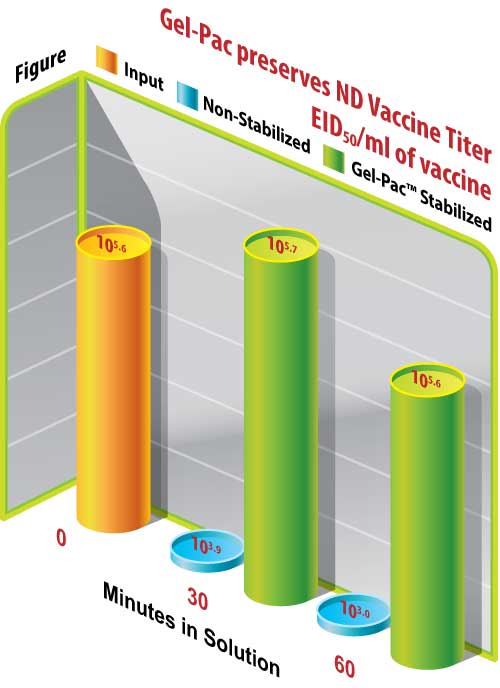
Gel-Pac® Streamlines Newcastle Vaccine and Oral Additive Delivery
Novel delivery systems for oral poultry health and nutrition products are opening doors, providing innovative and flexible management solutions for the food industry. These new technologies allow veterinarians and nutritionists to impact life-long bird wellbeing and performance as soon as the birds are hatched. Before the hatchlings exit the hatchery back door, they can be consuming hydrating gels that contain an ever-increasing offering of nutrients, probiotics and vaccines. Gel-Pac is a dry powdered gel concentrate that lets hatcheries efficiently prepare their own gel sprays from local tap water, then add and combine any variety of orally active products in a single application.
Gel-Pac was initially adopted by the poultry industry to deliver edible probiotics to hatchlings while still in the box, sprayed in gel droplets that the birds voraciously consumed by preening. Previous tests by UK researchers highlighted Gel-Pac’s ability to securely hold large coccidiosis (cocci) vaccine oocysts in suspension. This stable suspension ensured the vaccine could be uniformly delivered throughout a vaccination lasting over 4 hours, without the constant agitation required of ordinary water sprays. Other live vaccines, even common respiratory antigens, can also be orally active, either singly or in combination with each other. Infectious bronchitis and Newcastle disease (ND) vaccines are prime examples.
Interestingly, cocci vaccines are often manufactured with added chlorine, limiting their being combined with other more sensitive vaccines. Unlike the large and hardy cocci vaccine oocysts, ND vaccine particles are sensitive to chlorine or naturally-occurring oxidizers like iron, other mineral elements, or nitrate. Streamlining hatchery flow by combining the ND vaccination in an oral gel with other additives is potentially more efficient than separate treatments. For a fragile ND vaccine to be conveniently combined in a gel spray with hatchery tap water, the gel must not only provide positional stability, meaning freedom from settling, it must also insulate the vaccine from threats like oxidation, variable pH, and electrolyte balance in the case of bacterial antigens.
Stability Research
Poultry vaccine researchers at Lasher Associates experimented to learn if the protection Gel-Pac imparts to live probiotics could also extend to ND vaccine, rescuing it from inactivation throughout the gel spray process.
“Streamlining hatchery flow by combining the ND vaccination in an oral gel with other additives is potentially more efficient than separate treatments”.
As an oxidizer that is commonly found in tap water, chlorine represents a threat to ND vaccine, often causing hatcheries to spray it in distilled water solutions that are constantly agitated. If Gel-Pac could reliably protect sensitive ND vaccine in tap water, it would allow veterinarians to confidently and conveniently combine it in the gel carrier with other active biologicals, even cocci vaccine.
Method
A commercial live frozen ND vaccine from the VG-GA strain (VG-Vac®) was thawed in 30 C water, and then diluted to 1 label dose per ml in 3 different solutions:
- Distilled (DI) water, which verified the initial amount of vaccine input
- 4 ppm chlorinated DI water, serving as tap water
- 4 ppm chlorinated DI water plus Gel-Pac added at label concentration
Vaccine titers were measured in triplicate upon input and after 30 and 60 minutes in suspension using specific-pathogen-free (SPF) embryonated eggs. The method used was the one USDA requires of vaccine manufacturers in Title 9, Code of Federal Regulations §113.329. Geometric mean titers were calculated as EID50/ml of vaccine using the method of Reed and Muench.
Vaccine titers. The titer of the ND vaccine input at time 0 was 105.6 EID50/ml. The titer of ND vaccine exposed to ordinary chlorinated water solution for 30 minutes fell to 103.9 EID50/ml, and after 60 minutes decayed further to 103.0 EID50/ml. This aggressive inactivation by the water ultimately left only 2% of the vaccine activity remaining after 30 minutes and less than 1% after 60 minutes. In comparison, using Gel-Pac to stabilize the same water source in a suspension sustained the original vaccine potency, with titers at 30 and 60 minutes holding at 105.7 and
105.6 EID50/ml, respectively (figure).

Impact
Poultry hatcheries can feel the amplifying pressure; it results from their increasing one-day role in the life-long health of the flock and their responsibility to keep the hatchery operating efficiently. Using distilled water to spray the hatchery’s respiratory vaccines started as a way to avoid problems with the uncertainty of local water conditions and field vaccinations. The increasing number of vaccinations given in the hatchery has naturally lead veterinarians to look for ways to combine them into single applications. Now other orally active ingredients like probiotics and nutrients are entering the mix. Liquid sprays containing these ingredients are not ideal because oral additives do not function as an inhaled respiratory antigen would. But looking from another direction, it is possible to combine orally active vaccines for infectious bronchitis or ND in a convenient edible gel spray that carries other oral additives. Making the gel spray with local tap water can be an ideal solution, provided the gel can protect sensitive vaccines.
UK researchers previously showed how Gel-Pac uniformly suspends larger ingredients such as cocci vaccine oocysts without constant agitation. Lasher Associates’ new research opens the door to more options by confirming that Gel-Pac also protects ND vaccines from the severest oxidizers. By counteracting these risks, Gel-Pac makes it possible to conveniently and efficiently vaccinate with suspensions made from local water sources instead of costly and cumbersome bottled water. Further, by using a gel that nurtures vaccines in local tap water and also delivers oral additives, the possibility of combining multiple ingredients into a single application broadens the opportunities for managers to maintain efficiency.
Additional information and related articles on Gel-Pac®
SpecSheet | Spec Sheet Spanish | SDS | SDS Chinese | SDS Spanish Gel-Pac® new generation stabilizer aids in the administration of gel-delivered vaccines and probiotics for poultry. It is especially designed to prolong the viability and improve the effectiveness of reconstituted and diluted vaccines and probiotics in a gel that is convenient to prepare and easy for birds to consume.
RELATED ARTICLES:
Coccidia and IBV via Gel-Pac PDF
Gel-Pac Edible Gel for Vaccines PDF
Gel-Pac- The Ideal Gel Delivery System (booklet) ENGLISH | SPANISH
Gel-Pac New Generation Gel Delivery System with Stabilizer SELL SHEET
Gel-Pac® Permits Combining AviPro® Megan® Egg Salmonella Vaccine and Coccidiosis Vaccine for Hatchery Spray Application PDF | ARTICLE
Gel delivered vaccines, probiotics, and nutritional ingredients for poultry PDF | ARTICLE
Effects of Concentration and Temperature on the Viscosity of Gel-Pac PDF | ARTICLE
Gel-Pac Streamlines Newcastle Vaccine and Oral Additive Delivery PDF | ARTICLE
Gel-Pac Improving the titer of live infectious bronchitis vaccine for hatcheries PDF | SPANISH PDF | ARTICLE
Gel-Pac Efficacy of Gel-Pac Application for Poultry Coccidiosis Vaccination PDF | ARTICLE
Gel-Pac Enables Hatchery Vaccination with IB and Coccidiosis in Combination PDF | CHINESE PDF | ARTICLE
Gel-Pac Delivering Optimal Suspension PDF | SPANISH PDF| ARTICLE
